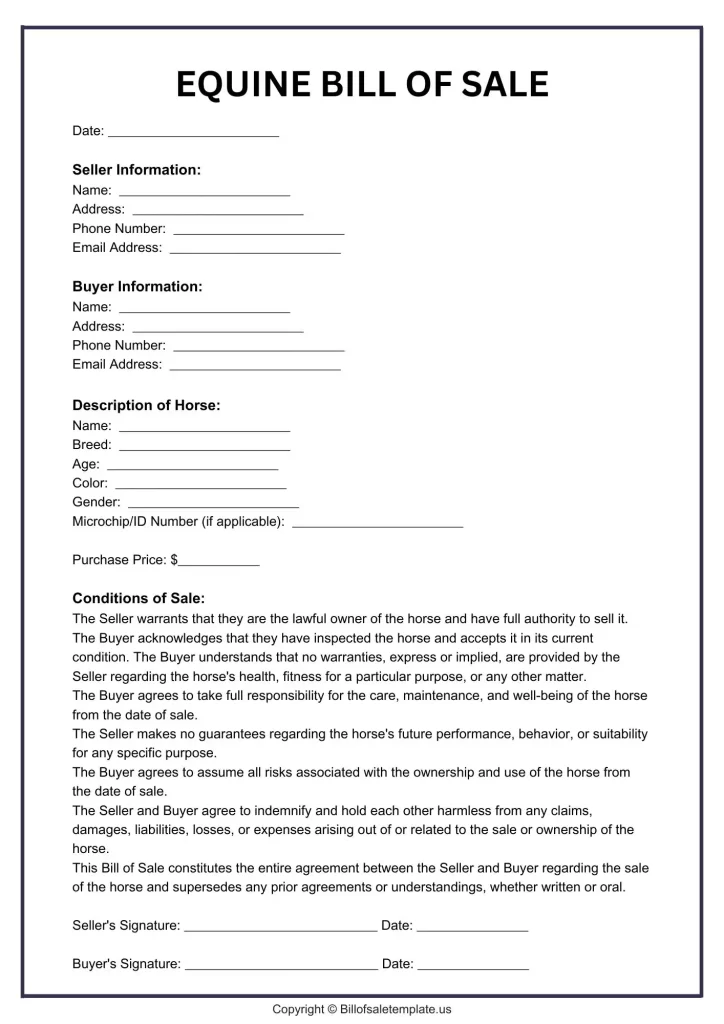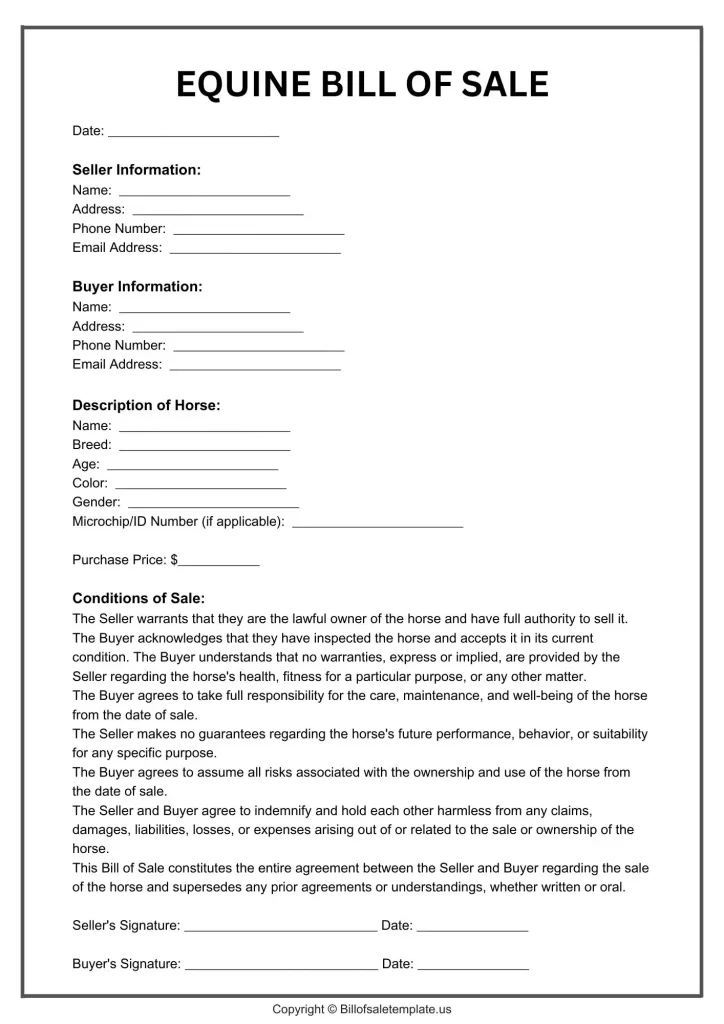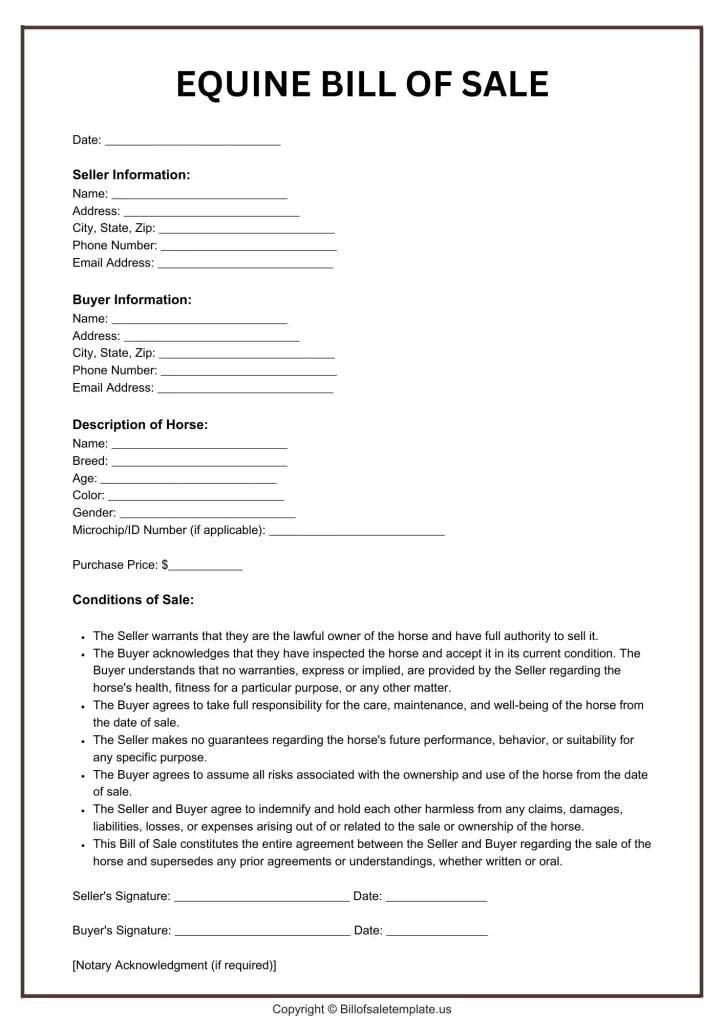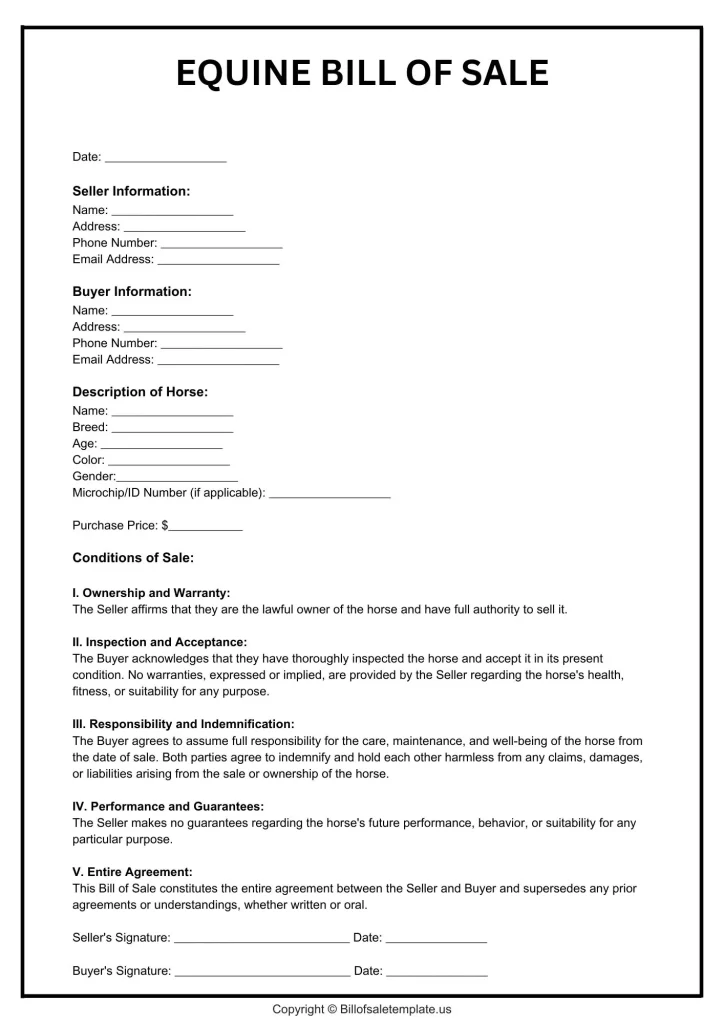An Equine Bill of Sale is a legal document used to record the sale and transfer of ownership of a horse from a seller to a buyer. It serves as a receipt for the purchase and provides important details about the transaction.
Printable Equine Bill of Sale Template
Here are the key elements typically included in an Equine Bill of Sale:
- Buyer and Seller Information: Full names, addresses, and contact details of both parties involved in the transaction.
- Horse Description: Detailed description of the horse, including name, breed, color, gender, age, markings, registration number (if applicable), and any other identifying characteristics.
- Sale Price: The agreed-upon price for the horse.
- Date of Sale: The date on which the sale takes place.
- Warranties and Disclosures: Any warranties or guarantees provided by the seller, or disclosures about the horse’s health, behavior, or training.
- Payment Terms: Details on how the payment is to be made (e.g., full payment upfront, installments).
- Signatures: Signatures of both the buyer and the seller to confirm their agreement to the terms outlined in the document.
- Witnesses/Notarization (if required): Some jurisdictions or circumstances might require the signatures to be witnessed or notarized to validate the document.
Equine Bill of Sale Contract
While there’s no universally mandated format for an Equine Bill of Sale Agreement, certain conditions are generally included to protect both the buyer and seller. Here are some key requirements:
Parties Involved:
- Identification: Include the full legal names, addresses, and contact information of both the buyer and seller.
Horse Description:
- Provide a detailed description of the horse, including:
- Name (if any)
- Breed
- Age
- Sex
- Color
- Markings
- Registration information (if applicable)
- Microchip/Tattoo/Brand information (if applicable)
Sales Agreement:
- Clear Title: The seller warrants they have a clear and legal title to the horse and the right to sell it.
- Purchase Price: Specify the total agreed-upon purchase price for the horse.
- Payment Terms: Outline the payment method (cash, installments, etc.) and timeline for completing the payment.
Transfer of Ownership:
- State that ownership of the horse transfers from the seller to the buyer upon full payment.
Optional Conditions:
- Health Information: Include any relevant health information about the horse, like recent veterinary exams or vaccinations.
- Disclaimers: The seller can include disclaimers regarding warranties, stating the horse is sold “as-is” unless otherwise specified.
- Transportation: Detail who is responsible for arranging and paying for the horse’s transportation to the buyer’s location.
- Risk of Loss: Indicate when the risk of loss or injury to the horse transfers from the seller to the buyer.
Signatures:
- Both the buyer and seller should sign and date the agreement in the presence of witnesses, who should also sign and date the document.
Notarization (Optional):
- While not always mandatory, getting the bill of sale notarized adds an extra layer of authenticity and can be helpful in case of disputes.
Recommendations:
- For added protection, consult with an attorney to ensure the agreement adheres to your state’s specific legalities.
Simple Equine Bill of Sale Agreement
Free Equine Bill of Sale Form
How to Notarized Equine Bill of Sale Form Template
To notarize an Equine Bill of Sale, you need to follow these steps:
- Prepare the Equine Bill of Sale Document:
- Ensure the document includes all necessary details such as the buyer’s and seller’s names and addresses, horse description (breed, age, color, markings), sale price, date of sale, and any warranties or conditions of the sale.
- Include a Notary Block:
- At the end of the document, include a notary block. This section provides space for the notary public to sign, stamp, and date the document. It should look something like this:
- Both Parties Appear Before the Notary:
- The buyer and seller must both appear in person before a notary public. Ensure each party has a valid photo ID for verification purposes.
- Sign the Document in the Presence of the Notary:
- Both parties must sign the Equine Bill of Sale in front of the notary public. The notary will then verify the identities of the signers and witness the signing.
- Notary Acknowledgment:
- The notary public will then complete the notary block by signing, dating, and stamping the document with their official notary seal.
- Record the Transaction:
- In some cases, you may need to record the notarized Equine Bill of Sale with a local government office, such as the county recorder’s office, especially if state law requires.

Ted Cruz is the founder and driving force behind BillofSaleTemplate.us, a comprehensive resource for free bill of sale templates tailored to meet a variety of needs. With a keen understanding of the importance of accurate and legally sound documentation, Ted has dedicated his expertise to providing accessible and user-friendly templates for all types of transactions, from vehicle sales to personal property exchanges.
Recognizing the diverse legal requirements across different states, Ted has meticulously crafted state-specific bill of sale templates to ensure compliance and ease of use for users nationwide. His commitment to simplifying the process of creating reliable and legally binding documents has made BillofSaleTemplate.us a trusted platform for individuals and businesses alike.
![Free Bill of Sale Template PDF, Word [United States]](https://billofsaletemplate.us/wordpress/wp-content/uploads/2024/06/bill-of-sale-Logo-1-189x74.png)



